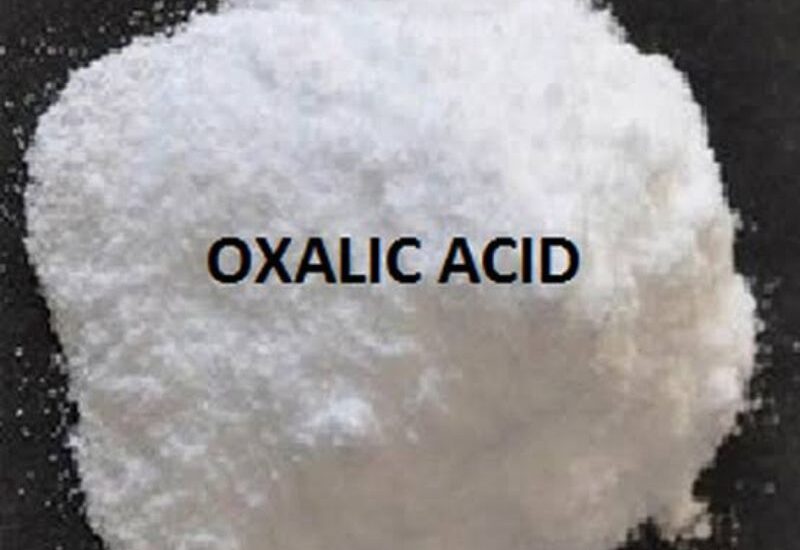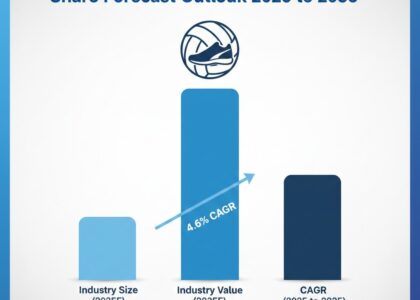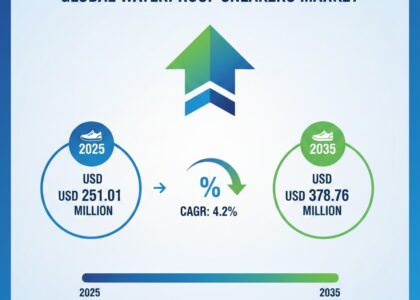The oxalic acid market, often associated with traditional uses such as household rust removers, bleaching agents, and pharmaceutical intermediates, has recently been gaining attention for a lesser-known industrial function: its critical role in rare earth metal extraction. While this application remains relatively underexplored in mainstream market reports, it holds significant potential to reshape both demand dynamics and investment trends in the organic acid industry. Often referred to by its IUPAC name, ethanedioic acid, oxalic acid’s ability to form stable, insoluble oxalates with rare earth elements makes it a linchpin in the global metallurgy sector.
According to Future Market Insights, the oxalic acid market is projected to grow from USD 1 billion in 2025 to USD 1.7 billion by 2035, registering a CAGR of 4.9% over the forecast period.
Request Your Sample and Stay Ahead with Our Insightful Report!
𝐈𝐧𝐭𝐫𝐨𝐝𝐮𝐜𝐭𝐢𝐨𝐧 𝐭𝐨 𝐎𝐱𝐚𝐥𝐢𝐜 𝐀𝐜𝐢𝐝 𝐌𝐚𝐫𝐤𝐞𝐭 𝐚𝐧𝐝 𝐀𝐥𝐭𝐞𝐫𝐧𝐚𝐭𝐞 𝐓𝐞𝐫𝐦𝐬
Ethanedioic acid, more commonly known as oxalic acid, is an organic compound with the formula C₂H₂O₄. It occurs naturally in many plants but is predominantly synthesized for industrial purposes. Traditionally, the oxalic acid market has been segmented into sectors such as cleaning and laundry products, pharmaceuticals, leather tanning, and dye production. However, in recent years, a growing share of the market has been quietly pivoting toward advanced industrial applications, particularly in metallurgy and inorganic separation processes. Among these, one of the most technologically relevant yet underreported uses is in the extraction and purification of rare earth elements (REEs).
𝐓𝐡𝐞 𝐂𝐡𝐞𝐦𝐢𝐬𝐭𝐫𝐲 𝐁𝐞𝐡𝐢𝐧𝐝 𝐑𝐚𝐫𝐞 𝐄𝐚𝐫𝐭𝐡 𝐄𝐱𝐭𝐫𝐚𝐜𝐭𝐢𝐨𝐧 𝐰𝐢𝐭𝐡 𝐎𝐱𝐚𝐥𝐢𝐜 𝐀𝐜𝐢𝐝
Oxalic acid serves as a highly effective precipitating agent in hydrometallurgical processes due to its ability to selectively bind with trivalent metal ions. During rare earth element extraction, especially from bastnaesite or monazite ores, REEs are initially dissolved in acid. Oxalic acid is then introduced to selectively precipitate these metals as oxalates, which can later be thermally decomposed to yield high-purity oxides such as neodymium oxide or lanthanum oxide.
The high selectivity and purity of precipitation offered by oxalic acid surpass other mineral acids in specific scenarios, especially where selective separation is crucial. This chemical pathway is not only more environmentally friendly compared to older solvent extraction methods but also enables lower operational costs and fewer secondary waste products. This has made oxalic acid indispensable in high-tech metal refining processes, particularly in regions where rare earth resource utilization is a matter of strategic importance.
𝐆𝐞𝐨𝐩𝐨𝐥𝐢𝐭𝐢𝐜𝐚𝐥 𝐚𝐧𝐝 𝐈𝐧𝐝𝐮𝐬𝐭𝐫𝐢𝐚𝐥 𝐈𝐦𝐩𝐨𝐫𝐭𝐚𝐧𝐜𝐞
China, which controls over 85% of the global rare earth processing capability, extensively uses oxalic acid in its separation and refining systems. In Jiangxi and Inner Mongolia, large-scale rare earth separation plants integrate oxalic acid in downstream hydrometallurgical processing to recover valuable lanthanides used in everything from wind turbines to military-grade electronics.
India also plays a growing role in this space. The Indian Rare Earths Limited (IREL) has been experimenting with oxalic acid-based precipitation for monazite sand processing along its southern coast. In these applications, oxalic acid not only improves yield but also enhances downstream thermal efficiency when converting oxalates into usable metal oxides.
𝐌𝐚𝐫𝐤𝐞𝐭 𝐓𝐫𝐞𝐧𝐝𝐬 𝐚𝐧𝐝 𝐈𝐧𝐯𝐞𝐬𝐭𝐦𝐞𝐧𝐭 𝐒𝐢𝐠𝐧𝐚𝐥𝐬
One of the least discussed ripple effects of the global electric vehicle (EV) boom and renewable energy push is the rising, indirect demand for oxalic acid. High-performance magnets in EV motors, wind turbines, and electronics require rare earth metals, which in turn rely on efficient and scalable extraction methods—many of which involve oxalic acid.
Though traditional market studies on the oxalic acid market forecast modest growth rates of 4.9% CAGR, they often fail to account for this latent demand from metallurgy and green tech sectors. Companies that supply oxalic acid, especially in high-purity or industrial-grade forms, could find new revenue streams by catering to REE processors. This transition might also lead to product diversification, with manufacturers developing specialized variants of ethanedioic acid tailored for high-efficiency metal precipitation.
𝐂𝐡𝐚𝐥𝐥𝐞𝐧𝐠𝐞𝐬 𝐚𝐧𝐝 𝐒𝐮𝐬𝐭𝐚𝐢𝐧𝐚𝐛𝐢𝐥𝐢𝐭𝐲 𝐈𝐬𝐬𝐮𝐞𝐬
Despite its advantages, the increased use of oxalic acid in metallurgical industries is not without environmental concerns. Improper disposal of oxalate-laden waste can lead to soil and water toxicity. In addition, large-scale usage can intensify the carbon footprint associated with oxalic acid production, which often involves petrochemical feedstocks.
To address these concerns, researchers are exploring greener synthesis methods. For example, a team at the Indian Institute of Technology (IIT) has demonstrated bio-based oxalic acid production using agricultural residues, which could drastically reduce environmental impact. Moreover, closed-loop processing systems in REE plants are being piloted to recover and reuse oxalic acid, minimizing waste.
𝐒𝐭𝐫𝐚𝐭𝐞𝐠𝐢𝐜 𝐎𝐮𝐭𝐥𝐨𝐨𝐤 𝐚𝐧𝐝 𝐅𝐮𝐭𝐮𝐫𝐞 𝐏𝐚𝐭𝐡𝐰𝐚𝐲𝐬
While the oxalic acid market continues to be categorized under commodity chemicals, its evolving role in the strategic domain of rare earth metal extraction signals a paradigm shift. This overlooked application area—often buried beneath discussions on rust removers and cleaning agents—could become a critical growth driver as nations intensify efforts to secure critical mineral supplies for their technological and energy needs.
Reach out to Sales to Secure Your Copy of the Report Now!
Understanding and investing in this intersection between oxalic acid and REE metallurgy is more than just niche market foresight—it’s strategic anticipation of a future where materials science and geopolitical economics are tightly interwoven. The ethanedioic acid market, though modest in size, is positioning itself as a quiet enabler of some of the world’s most transformative industries.
𝐊𝐞𝐲 𝐒𝐞𝐠𝐦𝐞𝐧𝐭𝐬 𝐏𝐫𝐨𝐟𝐢𝐥𝐞𝐝 𝐢𝐧 𝐭𝐡𝐞 𝐎𝐱𝐚𝐥𝐢𝐜 𝐀𝐜𝐢𝐝 𝐌𝐚𝐫𝐤𝐞𝐭 𝐒𝐮𝐫𝐯𝐞𝐲
By Grade:
The industry is segmented into standard grade (purity 96%-99%), technical/pharma grade (purity 99%-99.9%), and electronic/food grade (purity 99.9%-99.999%).
By Application:
The industry is segmented into bleaching & purifying agents, reducing agents, stain & rust removers, miticide, precipitation agents, and others.
By End Use:
The industry is segmented into petrochemicals, water treatment chemicals, metallurgy, textiles & leather, pharmaceuticals, electronics & semiconductors, food, wood pulp, and bee-hiving.
By Region:
The industry is segmented into North America, Latin America, Western Europe, Eastern Europe, South Asia and Pacific, East Asia, and Middle East and Africa.
𝐀𝐛𝐨𝐮𝐭 𝐅𝐮𝐭𝐮𝐫𝐞 𝐌𝐚𝐫𝐤𝐞𝐭 𝐈𝐧𝐬𝐢𝐠𝐡𝐭𝐬 (𝐅𝐌𝐈)
Future Market Insights, Inc. (ESOMAR certified, recipient of the Stevie Award, and a member of the Greater New York Chamber of Commerce) offers profound insights into the driving factors that are boosting demand in the market. FMI stands as the leading global provider of market intelligence, advisory services, consulting, and events for the Packaging, Food and Beverage, Consumer Technology, Healthcare, Industrial, and Chemicals markets. With a vast team of over 400 analysts worldwide, FMI provides global, regional, and local expertise on diverse domains and industry trends across more than 110 countries.
Join us as we commemorate 10 years of delivering trusted market insights. Reflecting on a decade of achievements, we continue to lead with integrity, innovation, and expertise.
𝐂𝐨𝐧𝐭𝐚𝐜𝐭 𝐔𝐬:
Future Market Insights Inc.
Christiana Corporate, 200 Continental Drive,
Suite 401, Newark, Delaware – 19713, USA
T: +1-347-918-3531
For Sales Enquiries: sales@futuremarketinsights.com
Website: https://www.futuremarketinsights.com
LinkedIn| Twitter| Blogs | YouTube






